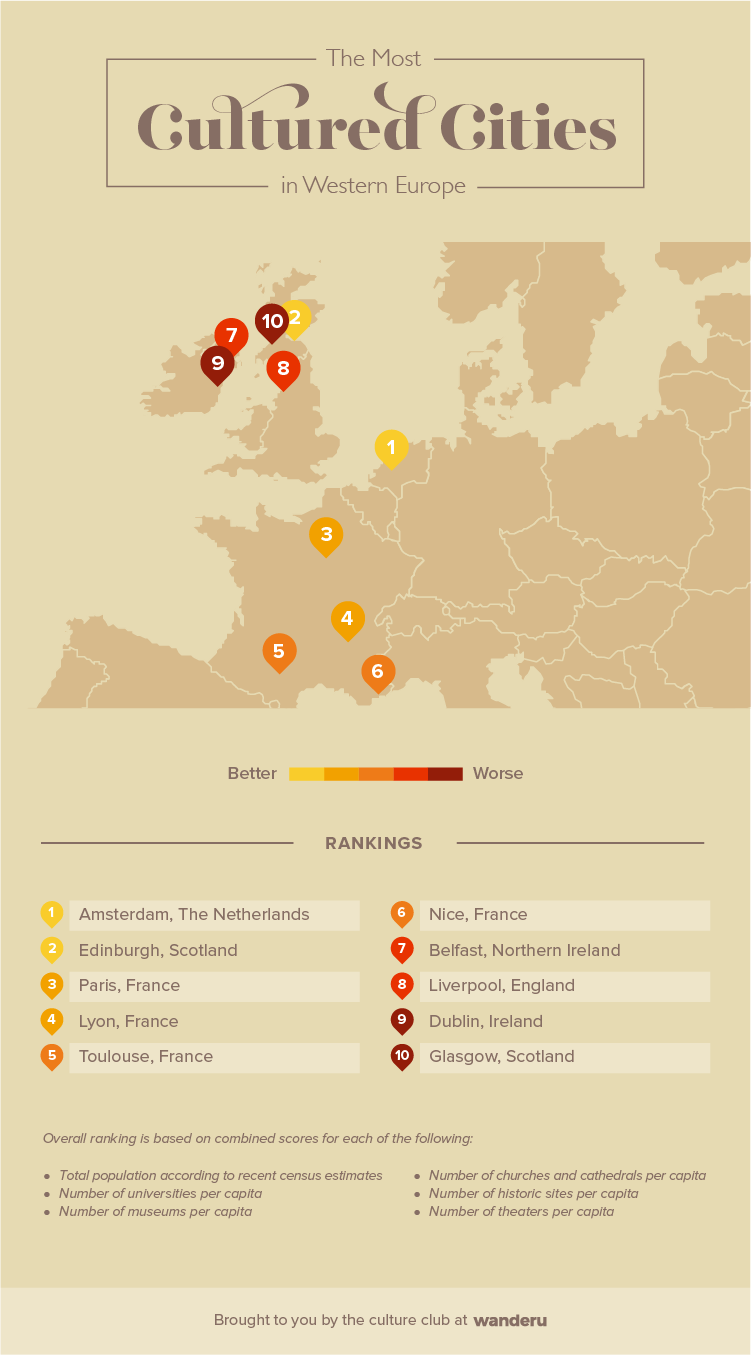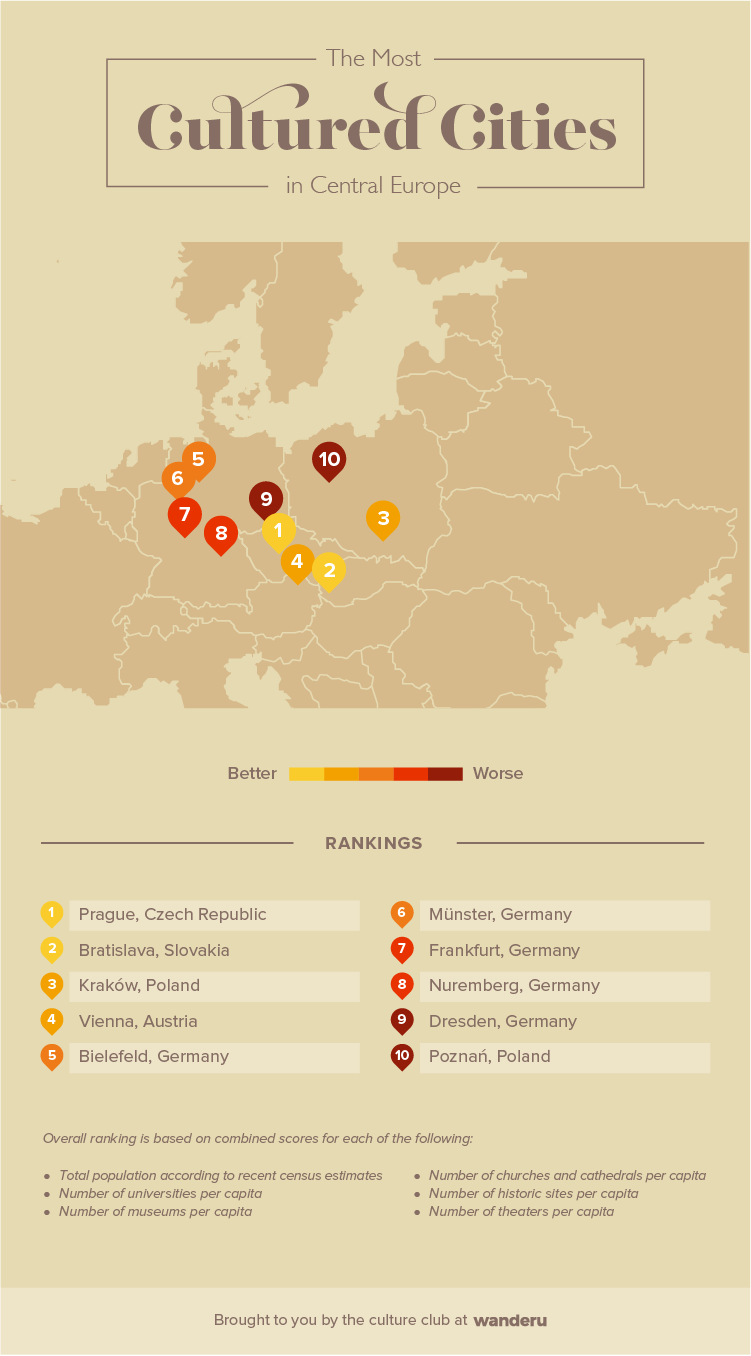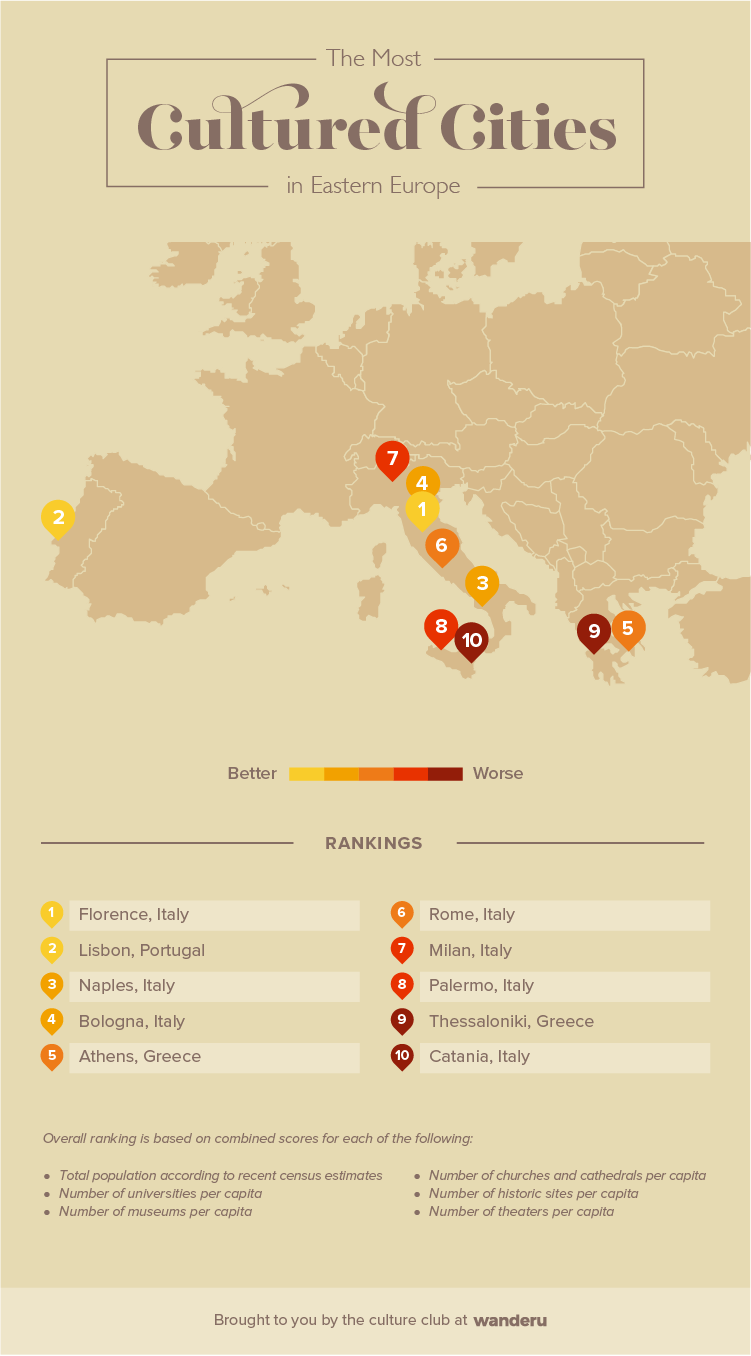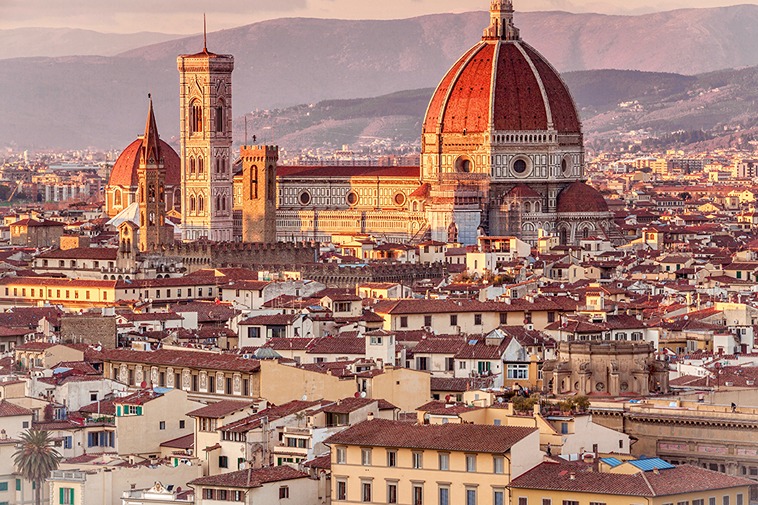Too much to see and not enough time — that’s the classic dilemma facing travelers with their eyes on Europe.
Almost every single city is rich with historical ruins that predate the U.S. (The Colosseum! The Parthenon!) and iconic sights that truly take your breath away (The Eiffel Tower! Sagrada Familia!). The highest profile places get the most attention, from London to Paris to Berlin and beyond. But spanning from the Atlantic to the Caspian Sea, there are dozens of other significant cities equally as alluring (dare we say, even more so?) that don’t typically get their due.
So, how does an intrepid traveler decide where to go?
Those in the know build their itineraries around cultural landmarks — the things they want to see and visit in each destination. Which is why we here at Wanderu decided to make it easy for you, and put together a definitive ranking of the “most cultured” cities in Europe.
Wanderu is your source for cheap plane, bus and train travel across Europe — one of the only places where you can compare and book every leg of your journey, whether it be via air or ground travel — on the same platform.
Using a specific methodology, we calculated the density of culturally important sites across European cities to determine which places pack the most cultural punch. Our sample size consisted of every city in Europe with a population of more than 300,000 and we built our rankings based on:
- the number of universities per capita,
- the number of museums per capita,
- the number of churches and cathedrals per capita,
- the number of historic sites per capita,
- and the number of theaters per capita.
The result: A ranking pinpointing the top 50 most culturally compelling cities across the Old Continent. See for yourself below.

Here you have it: Europe’s top 50 for culture. Passing the finish line at #1 is Florence, Italy’s Renaissance gem. To give you just a taste of Florence’s remarkable numbers, the (relatively) small city of less than 400,000 boasts more than 130 museums — among them, the Accademia Gallery, where you can see Michelangelo’s famous sculpture of David in his birthday suit. That’s more than enough to fill a day in Florence!
Lisbon, Portugal earns runner-up status with 29 universities (the most per capita of any city we considered) and, in general, is home to a wealth of cultural riches. But you don’t need a Ph.D to appreciate all it has to offer; just spend at least 2 days in Lisbon exploring its riches. Among them is the Mosteiro dos Jeronimos, a gorgeous monastery in the late Gothic style, where explorer Vasco de Gama (the first European to reach India by sea) is entombed.
Perhaps the biggest surprise of the top 10: Tallinn, Estonia, clocks in above Paris, France. For a city of its relatively humble size, Tallinn has a truly shocking number of museums (103!). To see how Estonians lived in the 18th and 19th centuries, visit the Eesti Vabaohumuuseum (Open Air Museum). You’ll be able to wander around the grounds and view historic architecture, while learning about the old ways of life in a truly serene setting.
Most Cultured European Cities by Region
Plenty of trip planning starts with geography. Where else can you travel to from where you’re going? What places can you find affordable tickets to in the first place? (Indeed, if affordability is your main motivating factor, check out our ranking of the cheapest and most expensive European capitals).
To that end, we’ve broken down our data discoveries into spatial subcategories to help you plan a regional trip — or five. Jump to a region below, or scroll to see them all.
Most Cultured Cities in Western Europe


|
        |
        |
||||
|---|---|---|---|---|---|---|
|
1. Amsterdam, The Netherlands |
864,217 | 6 | 198 | 22 | 77 | 48 |
| 2. Edinburgh, Scotland | 488,100 | 5 | 92 | 34 | 50 | 18 |
| 3. Paris, France | 2,140,526 | 26 | 292 | 133 | 68 | 134 |
| 4. Lyon, France | 513,275 | 7 | 43 | 27 | 4 | 29 |
| 5. Toulouse, France | 479,638 | 12 | 35 | 12 | 15 | 11 |
| 6. Nice, France | 342,637 | 1 | 40 | 15 | 5 | 14 |
|
7. Belfast, Northern Ireland |
340,200 | 1 | 43 | 7 | 19 | 9 |
| 8. Liverpool, England | 491,500 | 4 | 31 | 11 | 28 | 15 |
| 9. Dublin, Ireland | 1,173,149 | 11 | 106 | 83 | 40 | 23 |
| 10. Glasgow, Scotland | 615,070 | 5 | 58 | 10 | 18 | 19 |
- The figures featured above represent every city’s population according to recent census estimates, as well as the total number of universities, museums, churches/cathedrals, historic sites and theaters in each location.
- Final city rankings are based on per capita totals for each category.
We don’t see London, but we do see France: and four other United Kingdom cities, plus Dublin.
The takeaway here: The U.K. and France have this culture thing down, and southern France — particularly Toulouse and the beautiful town of Nice — is calling to you. (Most likely in a sexy accent.) Check out our itinerary to learn how you can visit 10 stunning cities in France for less than $150.
Also: We shouldn’t need to remind you of this, but Amsterdam is about a lot more than cannabis cafés. Not only is it the only city outside of Ireland, the U.K. and France on our list, but it snagged the #1 spot.
Why? Its 198 museums for one thing (that’s one for every 4,365 people), like the Van Gogh Museum, the Rembrandt House Museum and the Stedelijk Museum of contemporary art. Equally impressive is Amsterdam’s roster of historic sites: 77 in total, including the Anne Frank House. With so many unique things to do in Amsterdam, you’ll quickly see why we’ve ranked it so highly.
Most Cultured Cities in Central Europe


        |
        |
        |
||||
|---|---|---|---|---|---|---|
|
1. Prague, Czech Republic |
1,308,632 | 31 | 350 | 95 | 62 | 101 |
| 2. Bratislava, Slovakia | 429,564 | 11 | 50 | 13 | 13 | 3 |
| 3. Kraków, Poland | 771,069 | 12 | 96 | 31 | 17 | 11 |
| 4. Vienna, Austria | 1,898,000 | 22 | 147 | 52 | 56 | 48 |
| 5. Bielefeld, Germany | 332,552 | 4 | 34 | 10 | 13 | 5 |
| 6. Münster, Germany | 313,559 | 4 | 18 | 16 | 8 | 7 |
| 7. Frankfurt, Germany | 746,878 | 8 | 46 | 6 | 20 | 22 |
| 8. Nuremberg, Germany | 515,201 | 4 | 32 | 11 | 33 | 9 |
| 9. Dresden, Germany | 551,072 | 7 | 45 | 8 | 15 | 11 |
| 10. Poznań, Poland | 536,438 | 9 | 37 | 21 | 13 | 6 |
- The figures featured above represent every city’s population according to recent census estimates, as well as the total number of universities, museums, churches/cathedrals, historic sites and theaters in each location.
- Final city rankings are based on per capita totals for each category.
The Alps alone make Central Europe a sought-after destination, but man-made wonders — like the 101 theaters in Prague, including The Estates Theatre where Mozart conducted his first opera — merit your attention as well. There’s no shortage of things to do in Prague, and your trip will be well worth it. Expose your kids to the #1 most cultured city in Central Europe with this guide to Prague with kids.
And if you could high-five a city, we would high-five Bratislava, Slovakia, the underdog of them all coming in as the #2 city for the region. Even though it’s a city of less than 450,000 people, it has an incredible 50 museums. (We recommend the Nedbalka Gallery, the interior of which resembles the Guggenheim in New York.) Bratislava’s Old Town is also charming, lined with cobblestone streets, along with cafés and restaurants when your knees need a break from trodding on them. Don’t skip out on the pretty spectacular and under-visited castles in the city, too.
On a somber and must-be-acknowledged note: Many of the German and Polish cities listed have ready associations with World War II and the Holocaust. So keep in mind that a good number of the historic sites (and museums) are memorials to tragedies that took place within their borders. They are places to reckon with history — but also to see how these cities have survived, rebuilt and are thriving in their current culture.
Most Cultured Cities in Eastern Europe


        |
        |
        |
||||
|---|---|---|---|---|---|---|
| 1. Tirana, Albania | 418,495 | 23 | 20 | 1 | 2 | 3 |
| 2. St. Petersburg, Russia | 5,281,579 | 32 | 483 | 188 | 215 | 146 |
| 3. Yerevan, Armenia | 1,073,700 | 35 | 45 | 15 | 16 | 8 |
| 4. Constanța, Romania | 317,832 | 3 | 9 | 5 | 2 | 14 |
| 5. Tbilisi, Georgia | 1,158,700 | 35 | 42 | 29 | 6 | 13 |
| 6. Odessa, Ukraine | 1,029,049 | 15 | 65 | 46 | 3 | 14 |
| 7. Cluj-Napoca, Romania | 321,687 | 9 | 8 | 6 | 3 | 2 |
| 8. Sochi, Russia | 411,524 | 0 | 41 | 10 | 6 | 10 |
| 9. Plovdiv, Bulgaria | 368,983 | 8 | 32 | 8 | 3 | 0 |
| 10. Iași, Romania | 371,889 | 8 | 19 | 10 | 2 | 2 |
- The figures featured above represent every city’s population according to recent census estimates, as well as the total number of universities, museums, churches/cathedrals, historic sites and theaters in each location.
- Final city rankings are based on per capita totals for each category.
If you’ve not yet learned that you should be traveling to Eastern Europe, we kindly ask permission to shout: You should be traveling to Eastern Europe! Look at this list. This entire list.
Now St. Petersburg is — with great reason! — the most well-known destination on here, and you needn’t look further than its stats to understand why. But glance up a line at Tirana, Albania.
Tirana, the capital of Albania, is surrounded by mountains, and its climate is that of the Mediterranean. Even better, it’s just a short drive (about 40 minutes) to the breathtaking Adriatic coast. Not yet sold? Thanks to the variety of inhabitants it’s seen over the centuries, the ancient religious and architectural mix practically forms a history book — a history book about how a place recovers its culture post-Cold War. That includes the remnants of what was built during the Cold War, including a now-derelict concrete Stalinist pyramid: a strange and harrowing monument of the past.
Another major bonus? Tirana doesn’t get the huge influx of travelers many other cities see, and therefore locals are — wait for it — generally very excited to welcome visitors. Plus, we hear plum brandy is presented as a traditional greeting.
Finally, make sure you don’t sleep on Plovdiv, Bulgaria. It is 2019’s European Capital of Culture, and has Roman ruins more well-preserved (and far less packed) than you’ll find in Rome.
Most Cultured Cities in Northern Europe


        |
        |
        |
||||
|---|---|---|---|---|---|---|
| 1. Tallinn, Estonia | 441,101 | 11 | 103 | 23 | 21 | 10 |
| 2. Oslo, Norway | 634,293 | 11 | 108 | 42 | 20 | 14 |
| 3. Riga, Latvia | 641,423 | 20 | 75 | 25 | 14 | 7 |
| 4. Vilnius, Lithuania | 549,389 | 15 | 63 | 24 | 9 | 9 |
| 5. Copenhagen, Denmark | 777,218 | 9 | 109 | 28 | 25 | 16 |
| 6. Helsinki, Finland | 648,650 | 8 | 75 | 6 | 19 | 13 |
| 7. Stockholm, Sweden | 962,154 | 12 | 79 | 34 | 17 | 12 |
| 8. Gothenburg, Sweden | 571,868 | 2 | 26 | 7 | 9 | 7 |
| 9. Malmö, Sweden | 341,856 | 2 | 16 | 5 | 1 | 3 |
- There are only nine cities in this region because there were not 10 cities large enough to qualify.
- The figures featured above represent every city’s population according to recent census estimates, as well as the total number of universities, museums, churches/cathedrals, historic sites and theaters in each location.
- Final city rankings are based on per capita totals for each category.
Fjords for days.
That’s what we love about Scandinavia, and the Northern Lights are no joke, but the region has non-natural sights equally worth your attention. Those include the museums of Oslo and Copenhagen, or the churches, cathedrals, historic sites and — we presume — IKEAs of Stockholm.
But there’s more to see, starting with the #1 stop in Northern Europe, which also landed the #8 spot overall: Tallinn, Estonia. With two-thirds the population of Oslo, Tallinn has the same number of universities, one more historic site, and only five fewer museums. One of those historic sites: the Kiek in de Kök stacked-stone defensive towers. Built in the 1400s, the fortification is now welcoming people in rather than keeping them out.
If you haven’t already, then seriously, stop and Google Image Search “Tallinn.” It’s like Florence, Amsterdam, Barcelona and Moscow bundled up their most gorgeous aspects and sent them to this capital city by the Baltic Sea. If that’s not enough to convince you, check out all these awesome things you can do in Tallinn in just one visit.
Most Cultured Cities in Southern Europe


        |
        |
        |
||||
|---|---|---|---|---|---|---|
| 1. Florence, Italy | 381,030 | 1 | 136 | 145 | 86 | 17 |
| 2. Lisbon, Portugal | 505,526 | 29 | 128 | 65 | 18 | 21 |
| 3. Naples, Italy | 970,185 | 4 | 98 | 259 | 123 | 34 |
| 4. Bologna, Italy | 390,294 | 1 | 79 | 45 | 43 | 14 |
| 5. Athens, Greece | 664,046 | 9 | 107 | 26 | 23 | 29 |
| 6. Rome, Italy | 2,857,046 | 11 | 230 | 438 | 304 | 68 |
| 7. Milan, Italy | 1,395,274 | 7 | 190 | 127 | 97 | 48 |
| 8. Palermo, Italy | 664,182 | 1 | 35 | 125 | 69 | 15 |
| 9. Thessaloniki, Greece | 325,182 | 5 | 25 | 24 | 18 | 6 |
| 10. Catania, Italy | 312,505 | 1 | 30 | 30 | 19 | 7 |
- The figures featured above represent every city’s population according to recent census estimates, as well as the total number of universities, museums, churches/cathedrals, historic sites and theaters in each location.
- Final city rankings are based on per capita totals for each category.
Unsurprisingly, Italy is the big winner here.
But what may be surprising is that three Italian cities rate higher than Rome, and — with their smaller populations and territorial footprints — prove to be much more accessible to travelers.
While Italy has fewer universities than most other countries on the list, it’s not playing around when it comes to museums, churches/cathedrals and historic sites. We hardly need to make a list: Just drop yourself on a street in Bologna and you’ll bump into five on the same block. Even so, for the love of Florence: Do not miss out on the Duomo.
In non-Italy news: Lisbon’s got it going on across the board. Portugal’s capital city has views, architectural magic and history galore. Wrapped into one: The Casa dos Bicos, a house built in 1523 (and now home to the José Saramago Foundation), has a façade of diamond-shaped stones and a bizarrely enchanting assemblage of windows and doors.
And if you’re looking to mix culture with viniculture? Hit up the Wine and Vine Museum for a peek into regional winegrowing, which, naturally, you’ll need to taste for yourself later on.
The Most Cultured Cities by Category
Now let’s take this whole Euro-culture shabang and approach it a different way, instead asking: Where should you go if you want to find the most universities? Museums? Churches and Cathedrals? Historic Sites? Theaters? The answers await.
Cities With the Most Universities Per Capita
| Per Capita | |||
|---|---|---|---|
| 1. Lisbon, Portugal | 505,526 | 29 | 1 for every 17,432 people |
| 2. Tirana, Albania | 418,495 | 23 | 1 for every 18,195 people |
| 3. Yerevan, Armenia | 1,073,700 | 35 | 1 for every 30,677 people |
| 4. Riga, Latvia | 641,423 | 20 | 1 for every 32,071 people |
| 5. Tbilisi, Georgia | 1,158,700 | 35 | 1 for every 33,106 people |
| 6. Vilnius, Lithuania | 549,389 | 15 | 1 for every 36,626 people |
| 7. Bratislava, Slovakia | 429,564 | 11 | 1 for every 39,051 people |
| 8. Toulouse, France | 479,638 | 12 | 1 for every 39,970 people |
| 9. Tallinn, Estonia | 441,101 | 11 | 1 for every 40,100 people |
| 10. Prague, Czech Republic | 1,308,632 | 31 | 1 for every 42,214 people |
Sure, you’re probably not going to enroll, but a city’s universities are about more than higher ed. They are bastions of culture, past and present. They hold libraries, museums, galleries, gardens, architecture — many of the things we’re talking about when we say we’re interested in culture. They often reveal the DNA of a city, and also offer some pretty nice places to stroll and take in the scenery.
On a per-capita basis, Portugal’s Lisbon and Albania’s Tirana nearly double the closest competitor, with one university for every 17,432 and 18,195 residents, respectively.
Also of note: Eastern Europe is seriously flexing its cultural muscles on this particular list.
Cities With the Most Museums Per Capita
| Per Capita | |||
|---|---|---|---|
| 1. Florence, Italy | 381,030 | 136 | 1 for every 2,802 people |
| 2. Prague, Czech Republic | 1,308,632 | 350 | 1 for every 3,739 people |
| 3. Lisbon, Portugal | 505,526 | 128 | 1 for every 3,949 people |
| 4. Tallinn, Estonia | 441,101 | 103 | 1 for every 4,238 people |
| 5. Amsterdam, The Netherlands | 864,217 | 198 | 1 for every 4,365 people |
| 6. Bologna, Italy | 390,294 | 79 | 1 for every 4,940 people |
| 7. Edinburgh, Scotland | 488,100 | 92 | 1 for every 5,305 people |
| 8. Oslo, Norway | 634,293 | 108 | 1 for every 5,873 people |
| 9. Athens, Greece | 664,046 | 107 | 1 for every 6,206 people |
| 10. Copenhagen, Denmark | 777,218 | 109 | 1 for every 7,130 people |
Of all these categories, museums are likely top of mind when traveling for culture is a top consideration. And we don’t need to say — yet will most definitely reiterate — that Europe is not lacking on this front.
Not one of the top 10 cities in this category breaks the five-figures mark when it comes to museums per-capita. And that’s a good thing. Even Copenhagen, at #10, still has one museum for every 7,130 people. (We suggest The David Collection, world renowned for its assortment of Islamic art.)
Then, of course, there’s Florence, with its stunning statistic of one museum per 2,802 people. That’s 130 museums for a city of 381,030 people! Florence is home to the Uffizi Gallery, which is without doubt a bucket-list museum. Collection highlights include Botticelli’s “The Birth of Venus” and Da Vinci’s “The Annunciation.” Meanwhile, there are countless things to do in Athens to experience history, art, culture, and fun.
Really, you won’t go wrong with any city listed here, which is great news considering the vast range of regions that are represented.
Cities With the Most Churches & Cathedrals Per Capita
        |
        |
||
|---|---|---|---|
| 1. Florence, Italy | 381,030 | 145 | 1 for every 2,628 people |
| 2. Naples, Italy | 970,185 | 259 | 1 for every 3,746 people |
| 3. Palermo, Italy | 664,182 | 125 | 1 for every 5,313 people |
| 4. Rome, Italy | 664,182 | 438 | 1 for every 6,523 people |
| 5. Lisbon, Portugal | 505,526 | 65 | 1 for every 7,777 people |
| 6. Bologna, Italy | 390,294 | 45 | 1 for every 8,673 people |
| 7. Bari, Italy | 321,222 | 31 | 1 for every 10,362 people |
| 8. Catania, Italy | 312,505 | 30 | 1 for every 10,417 people |
| 9. Milan, Italy | 1,395,274 | 127 | 1 for every 10,986 people |
| 10. Seville, Spain | 689,434 | 54 | 1 for every 12,767 people |
You want churches? You want cathedrals? You want Italy. (If you read that in an Italian accent, well, that’s on you. But also, kind of appropriate.) It’s not the home of the Vatican City by accident, but the Pope’s place is hardly the only remarkable religious site.
Of course, there’s divinity in these places that has nothing to do with deities, too: the artwork, the architecture, the history — you don’t have to be a Believer to believe in the incredible monuments to culture these churches and cathedrals represent. (Bonus: They’re often free to enter.)
Even within the same country, the range of styles is remarkable, from St. Peter’s Basilica in Rome to the Museo Cappella Sansevero in Naples. All the more reason to make your way through all of Italy. (We happen to have an itinerary that takes you to every city on Italy’s hit list for less than $130.)
From there, stop by Spain and Portugal for — you know — comparison’s sake
Cities With the Most Historic Sites Per Capita
        |
        |
||
|---|---|---|---|
| 1. Florence, Italy | 381,030 | 86 | 1 for every 4,431 people |
| 2. Naples, Italy | 970,185 | 123 | 1 for every 7,888 people |
| 3. Bologna, Italy | 390,294 | 43 | 1 for every 9,077 people |
| 4. Rome, Italy | 664,182 | 304 | 1 for every 9,398 people |
| 5. Palermo, Italy | 664,182 | 69 | 1 for every 9,626 people |
| 6. Edinburgh, Scotland | 488,100 | 50 | 1 for every 9,762 people |
|
7. Amsterdam, The Netherlands |
864,217 | 77 | 1 for every 11,224 people |
| 8. Genoa, Italy | 580,097 | 44 | 1 for every 13,184 people |
| 9. Milan, Italy | 1,395,274 | 97 | 1 for every 14,384 people |
| 10. Nuremberg, Germany | 515,201 | 33 | 1 for every 15,612 people |
Italy is the big fish in the pond here, too. The Roman Empire may have fallen, but its grandeur lives on.
But let’s step out of the boot for a bit, and take a look at Edinburgh, Scotland, the top-ranking non-Italian city on our list. First up: Castles! The Edinburgh Castle, for starters. It lived through siege after siege, and from its perch atop a (not joking) volcano, you’re also granted access to some of the most glorious possible views of the city. There’s also Craigmillar Castle, abbeys like Inchcolm (on an island!) and Holyrood, and (creepily) housed underground, Real Mary King’s Close.
Edinburgh’s Old Town has history alongside modern life à la shops, restaurants, cafés and pubs — and, nearby, the easily strollable Water of Leith walkway. Plan to spend at least 2 days in Edinburgh to soak it all in!
Cities With the Most Theaters Per Capita
        |
        |
||
|---|---|---|---|
|
1. Prague, Czech Republic |
1,308,632 | 101 | 1 for every 12,957 people |
| 2. Paris, France | 2,140,526 | 134 | 1 for every 15,974 people |
| 3. Lyon, France | 513,275 | 29 | 1 for every 17,699 people |
|
4. Amsterdam, The Netherlands |
864,217 | 48 | 1 for every 18,005 people |
| 5. Florence, Italy | 381,030 | 17 | 1 for every 22,414 people |
| 6. Constanța, Romania | 317,832 | 14 | 1 for every 22,702 people |
| 7. Athens, Greece | 664,046 | 29 | 1 for every 22,898 people |
| 8. Lisbon, Portugal | 505,526 | 21 | 1 for every 24,073 people |
| 9. Nice, France | 342,637 | 14 | 1 for every 24,474 people |
| 10. Edinburgh, Scotland | 488,100 | 18 | 1 for every 27,117 people |
The cities that rank high for theaters represent a rather large geographical spread (hey, Romania!), and many of these smaller cities — three on the list have fewer than 400,000 residents — offer some extraordinary theatrical experiences.
But playing the straight numbers game, two cities clearly jump off the list here: Prague and Paris, each with more than 100 theaters within their city limits. To focus in on #1, the National Theatre in Prague, which presents drama, ballet and opera, has been the city’s mainstage for more than 130 years. There’s also Ta Fantastika, a black-light theater light show. So, um, some range. Also not to miss: Kino Lucerna — a movie theater housed in a spectacular, historic theatre-theater.
City-to-City With Wanderu
So, if sophistication is your scene, allow these comprehensive rankings to dictate your next European adventure.
Next step: Cross-reference this list with our study on the cheapest and most expensive European capitals, and you can get a clear idea which locales provide the most brain stimulation for your buck.
Or maybe hit multiple cultured cities in one go — try Florence to Naples, Paris to Amsterdam or Riga to Tallinn. Compare routes, schedules and prices from various bus and train carriers to book the cheapest trip available. Book your bus and train travel between cities across Europe on Wanderu.com or on the go with the Wanderu app. Spend your money on some souvenirs, not overpriced tickets.
Just plug in a city from the list above and prepare for some serious culture shock — in the very best sense.
Methodology
We analyzed the following categories to determine the Most Cultured European Cities:
- Total population according to recent census estimates
- Number of universities per capita
- Number of museums per capita
- Number of churches and cathedrals per capita
- Number of historic sites per capita
- Number of theaters per capita
Data sourcing:
- For population, we pulled all the cities in Europe with a population of more than 300,000 from the World Population Review and other recent census resources.
- For the number of universities, we counted the total number of “Universities” in each city from uniRank. With that information, we calculated the total per capita to determine which cities had the most universities in relation to their total population.
- For the number of museums, we counted the total number of “Museums” in each city from TripAdvisor. With that information, we calculated the total per capita to determine which cities had the most museums in relation to their population.
- For the number of churches and cathedrals, we counted the total number of “Churches & Cathedrals” in each city from TripAdvisor. With that information, we calculated the total per capita to determine which cities had the most churches and cathedrals in relation to their population.
- For the number of historic sites, we counted the total number of “Historic Sites” in each city from TripAdvisor. With that information, we calculated the total per capita to determine which cities had the most historic sites in relation to their population.
- For the number of theaters, we counted the total number of “Theaters” in each city from TripAdvisor. With that information, we calculated the total per capita to determine which cities had the most theaters in relation to their population.
- Finally, we normalized each category, combining the numbers into an overall score for each of the cities.
- Our final rankings consist of 167 cities with complete data for every category.
You are welcome to use the information and graphics on this page, crediting Wanderu. If you do so, please link back to this page, so that culture vultures around the world can see all the data and find out how we came up with the rankings.






